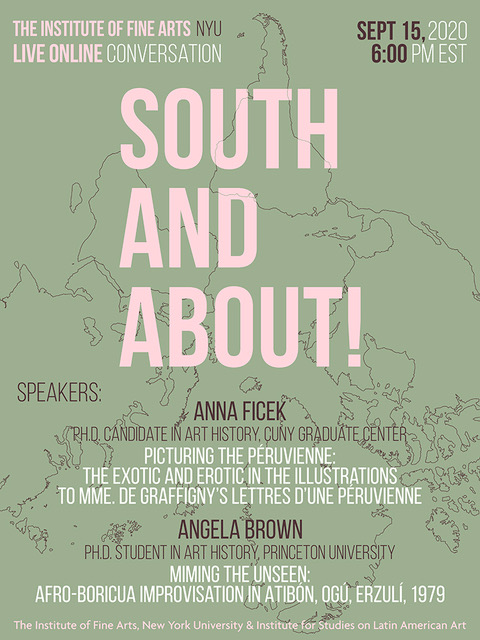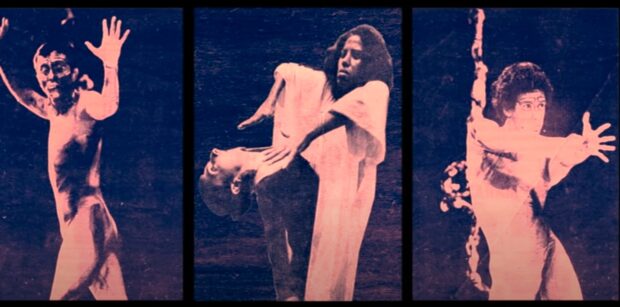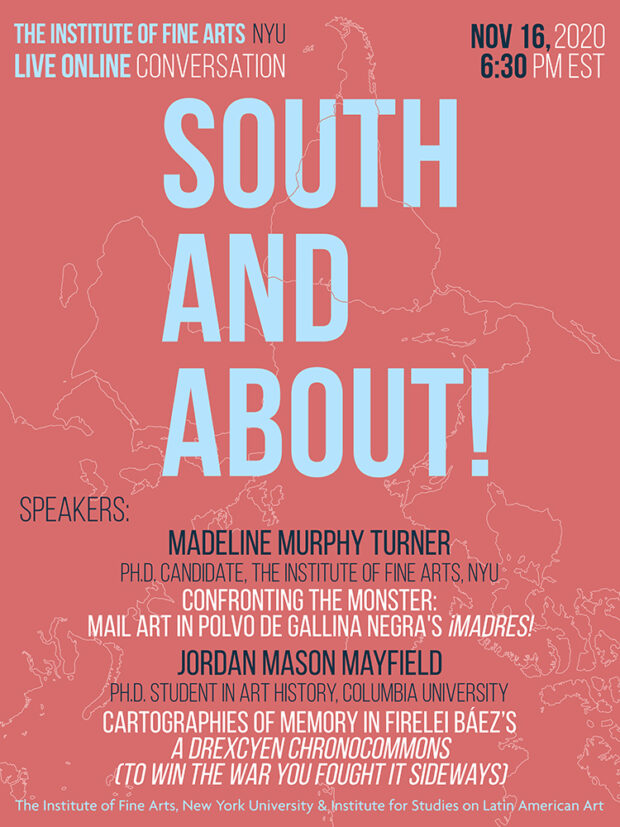South and About! Fall 2020
November 16
South & About! is a student-organized research workshop on the arts from Latin America and the Caribbean. This program invites graduate students and emerging scholars in art history and related disciplines to participate in informal discussions amongst their peers.
To register for the online event, please write to, fif204@nyu.edu
Confronting the Monster: Mail Art in Polvo de Gallina Negra’s ¡MADRES!
Madeline Murphy Turner, Ph.D. Candidate, The Institute of Fine Arts, NYU

Cartographies of Memory in Firelei Baez’s A Drexcyen Chronocommons (To win the war you fought it sideways)
Jordan Mayfield, Ph.D. Student, Columbia University
What does it mean to give shape and form to memory? Furthermore, what does it mean to envision a memory that has yet to happen? Or a memory that only exists in what Tina Campt calls the “future real conditional” or the Black queer feminist “performance of a future that hasn’t yet happened but must?”[1] How does one physicalize this Black feminist memory or alternative temporal dimension? Firelei Báez’s A Drexcyen Chronocommons (To win the war you fought it sideways) imagines another sphere of existence for descendants of enslaved Africans in the midst of legacies of enslavement and colonization. Employing Katherine McKittrick’s theorizations on Black geographies from Demonic Grounds: Black Women and the Cartographies of Struggle, I map out how Báez configures trans-temporal realms that combine the past, present, and future in order to envision schematics of new terrains of Afro-diasporic life.
1. Tina M. Campt, “Quiet Soundings: The Grammar of Black Futurity,” in Listening to Images (Durham: Duke University Press, 2017), 17.
September 15

South & About! is a student-organized research workshop on the arts from Latin America and the Caribbean. This program invites graduate students and emerging scholars in art history and related disciplines to participate in informal discussions amongst their peers.
To register for the online event, please write to, fif204@nyu.edu
Picturing the Péruvienne: the Exotic and Erotic in the illustrations to Mme. de Graffigny’s Lettres d’une Péruvienne
Agnieszka Anna Ficek, Ph.D. Candidate in Art History, The Graduate Center/CUNY
Delafosse, Jean Charles after Eisen, Charles-Joseph-Dominique Eisen, “Frontispiece,” illustration, 1751, Bibliotheque nationale de France, Paris, in Lettres d’une Peruvienne [vol 1], by Françoise de Graffigny, figure 1, Paris: Duchesne, 1752.
Madame de Graffigny’s Lettres d’une Péruvienne (first published 1747) was a renowned bestseller, widely translated, and published in multiple editions. The titular character, the Peruvian princess, Zilia, who was kidnapped by the Spanish conquistadors and rescued by French sailors, is commonly understood as an allegorical device that allowed Graffigny to level critique against the patriarchal systems of ancien regime France. This paper examines the way that objects in illustrations of the péruvienne in several key editions of Graffigny’s novel communicated racial and cultural differences and explores the theme of ‘colonial fantasy’ that was central in Inca-themed Francophone literature of the period. Starting with Charles Dominique Eisen’s illustrations for the 1752 edition, the visual representations of Zilia emphasize the themes of personal autonomy and identity so central to Graffigny’s proto-feminist epistolary fiction. When compared to the 1797 illustrations by Lefevre and Le Barbier, it is apparent that later images privilege the eroticized and exoticized virginal body of the péruvienne as opposed to her pre-established role as a “spokeswoman for the Incas’ lost glory”. (1) Finally, this paper also explores how the péruvienne became a trope in eighteenth-century French visual culture beyond Graffigny’s novel. The French artists who constructed such Inca were not concerned with accuracy but instead aimed to tantalize by presenting an alluring American princess in need of rescue from the cruelties and fanaticism of the villainous conquistador who embodied Spain. Proud, yet pretty and pliable, the péruvienne was cast as a conquerable object in French fantasies of South America.
(1) Deborah Poole, Vision, Race, and Modernity: A Visual Economy of the Andean Image World. 1 Princeton, NJ: Princeton University Press (1997): 41
Miming the Unseen: Afro-Boricua Improvisation in Atibón, Ogú, Erzulí (1979)
Angela H. Brown, Ph.D. student in Art History, Princeton University

Still from ATIBÓN, OGÚ, ERZULÍ (Fragmentos), 2015, a post-production of Luna Films for Producciones ADQ El Arca de Noé. Original Kodak Super8mm footage by Arcadio Díaz-Quiñones, 1979.
On April 5, 1979, the Taller de Histriones—an experimental miming company founded by Gilda Navarra—presented a choreodrama titled Atibón, Ogú, Erzulí at the University of Puerto Rico, Río Piedras. Choreographed by Alma Concepción, the performance was based on a text by Antonio T. Díaz-Royo, Loas (1968), which presents a series of narratives about three Afro-Caribbean deities prominent in Haitian Vodou: Atibón-Legbá (guardian of roads and memory); Ogú (god of resistance and rapture); and Erzulí (god of the erotic and of dreams).
Atibón, Ogú, Erzulí attest to a renewed embrace of Afro-Caribbean culture in Puerto Rico and the diaspora in the late 1970s. However, the members of the Taller de Histriones were not familiar with the loas before reading Díaz-Royo’s text. They sought to embody what they did not know, or what they had never seen directly. Why didn’t they draw from Afro-Boricua traditions, such as Espiritismo, bomba, and plena? What is the significance of drawing from modern dance, ballet, and pantomime instead?
In this paper, I use what remains of Atibón, Ogú, Erzulí—a Super8 film, a recording of the original music, news clippings, and oral histories—to build an expanded network of direct and indirect influences that includes Alvin Ailey, John Cage, Katherine Dunham, Martha Graham, Antonio Martorell, Alberto Méndez, Eduardo Rivero, and The Young Lords. By revealing links between seemingly disparate narratives, I consider how Atibón, Ogú, Erzulí might model a new approach to the Puerto Rican archive—activating both its stories and its silences.

